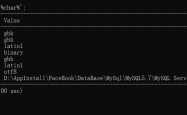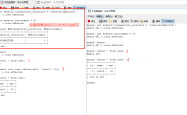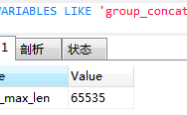MySQL两种删除用户语句的区别(delete user和drop user)
Tip:
在MySQL中,我们经常需要创建用户和删除用户,创建用户时,我们一般使用create user或者grant语句来创建,create语法创建的用户没有任何权限,需要再使用grant语法来分配权限,而grant语法创建的用户直接拥有所分配的权限。在一些测试用户创建完成之后,做完测试,可能用户的生命周期就结束了,需要将用户删除,而删除用户在MySQL中一般有两种方法,一种是drop user,另外一种是delete from mysql.user,那么这两种方法有什么区别呢?我们这里通过例子演示。
delete from mysql.user
首先,我们看看delete from mysql.user的方法。我们创建两个用户用来测试,测试环境是MySQL5.5版本,用户名分别为yeyz@'%'和yeyz@'localhost',创建用户的语法如下:
| 1 2 3 4 5 6 7 8 9 10 11 12 13 | mysql 15:13:12>> create user yeyz@ '%' identified by '123456' ; Query OK, rows affected (. sec) mysql 15:20:01>> grant select , create , update , delete on yeyz.yeyz to yeyz@ '%' ; Query OK, rows affected (. sec) mysql 15:29:48>> GRANT USAGE ON yeyz.yeyz TO 'yeyz' @localhost IDENTIFIED BY '123456' ; Query OK, rows affected (. sec) mysql --dba_admin@127...1:(none) 15:20:39>>show grants for yeyz@'%'; + -----------------------------------------------------------------------------------------------------+ | Grants for yeyz@% | + -----------------------------------------------------------------------------------------------------+ | GRANT USAGE ON *.* TO 'yeyz' @ '%' IDENTIFIED BY PASSWORD '*6BB4837EB74329105EE4568DDA7DC67ED2CA2AD9' | | GRANT SELECT , UPDATE , DELETE , CREATE ON `yeyz`.`yeyz` TO 'yeyz' @ '%' | + -----------------------------------------------------------------------------------------------------+ |
此时我们通过delete的方法手动删除mysql.user表中的这两个用户,在去查看用户表,我们发现:
?| 1 2 3 4 5 6 7 8 9 10 11 12 | mysql 15:20:43>> delete from mysql. user where user = 'yeyz' ; Query OK, rows affected (. sec) mysql 15:21:40>> select user ,host from mysql. user ; + ------------------+-----------------+ | user | host | + ------------------+-----------------+ | dba_yeyz | localhost | | root | localhost | | tkadmin | localhost | + ------------------+-----------------+ rows in set (. sec) |
已经没有这两个yeyz的用户了,此时我们使用show grants for命令查看刚才删除的用户,我们发现依旧是存在这个用户的权限说明的:
?| 1 2 3 4 5 6 7 8 | mysql 15:24:21>>show grants for yeyz@ '%' ; + -----------------------------------------------------------------------------------------------------+ | Grants for yeyz@% | + -----------------------------------------------------------------------------------------------------+ | GRANT USAGE ON *.* TO 'yeyz' @ '%' IDENTIFIED BY PASSWORD '*6BB4837EB74329105EE4568DDA7DC67ED2CA2AD9' | | GRANT SELECT , UPDATE , DELETE , CREATE ON `yeyz`.`yeyz` TO 'yeyz' @ '%' | + -----------------------------------------------------------------------------------------------------+ rows in set (0.00 sec) |
说明我们虽然从mysql.user表里面删除了这个用户,但是在db表和权限表里面这个用户还是存在的,为了验证这个结论,我们重新创建一个yeyz@localhost的用户,这个用户我们只给它usage权限,其他的权限我们不配置,如下:
?| 1 2 | mysql ::>> GRANT USAGE ON yeyz.yeyz TO 'yeyz' @localhost IDENTIFIED BY '123456' ; Query OK, rows affected (. sec) |
这个时候,我们使用yeyz@localhost这个用户去登陆数据库服务,然后进行相关的update操作,如下:
?| 1 2 3 4 5 6 7 8 9 10 11 12 13 14 15 16 17 18 19 20 21 22 23 24 25 26 27 28 29 30 31 32 33 34 35 | [dba_mysql@tk-dba-mysql-stat -- ~]$ /usr/local/mysql/bin/mysql -uyeyz --socket=/data/mysql_4306/tmp/mysql.sock --port= -p -hlocalhost Enter password : Welcome to the MySQL monitor. Commands end with ; or \g. Your MySQL connection id is Server version: 5.5.-log MySQL Community Server (GPL) Copyright (c) , , Oracle and / or its affiliates. All rights reserved. Oracle is a registered trademark of Oracle Corporation and / or its affiliates. Other names may be trademarks of their respective owners. Type 'help;' or '\h' for help. Type '\c' to clear the current input statement. mysql --yeyz@localhost:(none) 15:31:05>>select * from yeyz.yeyz; + ------+ | id | + ------+ | 3 | | 4 | | 5 | + ------+ rows in set (. sec) mysql --yeyz@localhost:(none) 15:31:16>>delete from yeyz.yeyz where id=; Query OK, row affected (. sec) mysql --yeyz@localhost:(none) 15:31:32>>select * from yeyz.yeyz; + ------+ | id | + ------+ | 3 | | 4 | + ------+ rows in set (. sec) |
最终出现的结果可想而知,一个usage权限的用户,对数据库总的表进行了update操作,而且还成功了。这一切得益于我们delete from mysql.user的操作,这种操作虽然从user表里面删除了记录,但是当这条记录的host是%时,如果重新创建一个同名的新用户,此时新用户将会继承以前的用户权限,从而使得用户权限控制失效,这是很危险的操作,尽量不要执行。
再开看看drop的方法删除用户
首先,我们删除掉刚才的那两个用户,然后使用show grants for语句查看他们的权限:
?| 1 2 3 4 5 6 7 8 9 | mysql ::>> drop user yeyz@ '%' ; Query OK, rows affected (0.00 sec) mysql ::>> drop user yeyz@ 'localhost' ; Query OK, rows affected (0.00 sec) mysql ::>> mysql ::>>show grants for yeyz@ '%' ; ERROR (): There is no such grant defined for user 'yeyz' on host '%' mysql ::>>show grants for yeyz@ 'localhost' ; ERROR (): There is no such grant defined for user 'yeyz' on host '192.168.18.%' |
可以看到,权限已经完全删除了,此时我们重新创建一个只有select权限的用户:
?| 1 2 | mysql ::>> GRANT SELECT ON *.* TO 'yeyz' @ 'localhost' IDENTIFIED BY PASSWORD '*6BB4837EB74329105EE4568DDA7DC67ED2CA2AD9' ; Query OK, rows affected (. sec) |
我们使用这个用户登录到数据库服务,然后尝试进行select、update以及create操作,结果如下:
?| 1 2 3 4 5 6 7 8 9 10 11 12 13 14 15 16 17 18 19 20 21 22 23 24 25 26 27 28 29 30 | [dba_mysql@tk-dba-mysql-stat-10-104 ~]$ /usr/ local /mysql/bin/mysql -uyeyz --socket=/data/mysql_4306/tmp/mysql.sock --port=4306 -p -hlocalhost Enter password : Welcome to the MySQL monitor. Commands end with ; or \g. Your MySQL connection id is Server version: 5.5.19-log MySQL Community Server (GPL) Copyright (c) , , Oracle and / or its affiliates. All rights reserved. Oracle is a registered trademark of Oracle Corporation and / or its affiliates. Other names may be trademarks of their respective owners. Type 'help;' or '\h' for help. Type '\c' to clear the current input statement. mysql ::>> select * from yeyz.yeyz; + ------+ | id | + ------+ | | | | | | + ------+ rows in set (0.00 sec) mysql ::>> update yeyz.yeyz set id= where id=; ERROR (): UPDATE command denied to user 'yeyz' @ 'localhost' for table 'yeyz' mysql ::>> create table test (id int ); ERROR (D000): No database selected mysql ::>> create table yeyz.test (id int ); ERROR (): CREATE command denied to user 'yeyz' @ 'localhost' for table 'test' |
可以发现,这个用户只可以进行select操作,当我们尝试进行update操作和create操作的时候,系统判定这种操作没有权限,直接拒绝了,这就说明使用drop user方法删除用户的时候,会连通db表和权限表一起清除,也就是说删的比较干净,不会对以后的用户产生任何影响。
结论:
当我们想要删除一个用户的时候,尽量使用drop user的方法删除,使用delete方法可能埋下隐患,下次如果创建同名的用户名时,权限控制方面存在一定的问题。
这个演示也解决了一些新手朋友们的一个疑问:为什么我的用户只有usage权限,却能访问所有数据库,并对数据库进行操作?这个时候,你需要看看日志,查询自己有没有进行过delete from mysql.user的操作,如果有,这个问题就很好解释了。
以上就是MySQL两种删除用户语句的区别(delete user和drop user)的详细内容,更多关于MySQL 删除用户的资料请关注服务器之家其它相关文章!
原文链接:https://cloud.tencent.com/developer/article/1533576
1.本站遵循行业规范,任何转载的稿件都会明确标注作者和来源;2.本站的原创文章,请转载时务必注明文章作者和来源,不尊重原创的行为我们将追究责任;3.作者投稿可能会经我们编辑修改或补充。











